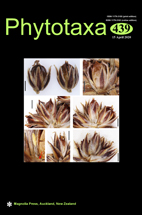Abstract
A new species of Juncus from Honduras is described, illustrated, and a key is provided to separate it from related Neotropical species in Juncus sect. Ozophyllum. Juncus hondurensis is similar to J. articulatus, which occurs worldwide, but differs in having smaller seeds ((0.3–)0.4–0.44 × 0.16–0.21 mm) that are 14–16-striate (vs. 0.45–0.6 × 0.24–0.26 mm and 25-striate in J. articulatus). The new species also resembles J. pallescens, which is widely distributed in South America and SE Australia, but differs in having shorter tepals (outer ones 2.5–3(–3.3) mm long, inner ones 2.3–2.6(–2.8) mm long, and inner tepals shorter than outer ones (sometimes only slightly), or rarely longer, acute) and filaments ((0.65–)0.75–0.85(–0.9) mm long) (vs. tepals 3.0–4.5 mm long, subequal, acuminate, and filaments (0.6–)1.0–1.2 mm long in J. pallescens). Juncus hondurensis is also compared to other taxa in a key to the Neotropical Juncus, with particular emphasis on the morphology of their fruits.

